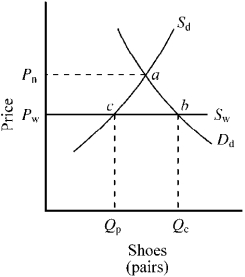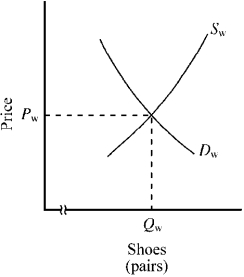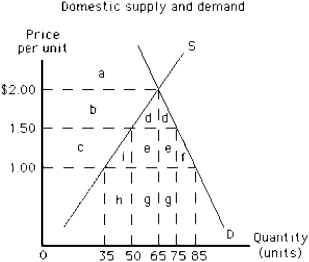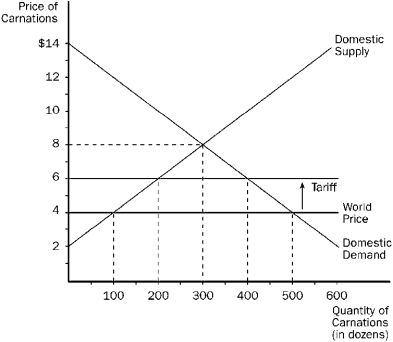A) No,these are incompatible on theoretical grounds.
B) No,theory prevents it,but some economists claim it could occur.
C) Yes,this situation can occur.
D) Yes,in theory,although not in reality.
Correct Answer

verified
Correct Answer
verified
Multiple Choice
The following table indicates the production possibilities of food and clothing per worker day in the United States and Japan.
 Which of the following is true?
Which of the following is true?
A) Since U.S.workers produce more of both food and clothing than Japanese workers,no gains from trade are possible.
B) Mutual gains from trade could be realized if the United States specialized in food production and Japan in clothing production.
C) The Japanese are the low-cost producers of both food and clothing.
D) Joint output would be maximized if the United States specialized in producing clothing and Japan in producing food.
Correct Answer

verified
Correct Answer
verified
Multiple Choice
International trade is advantageous because trade makes it possible for people in each country to
A) import more than they export.
B) export more than they import.
C) employ more of their domestic resources producing things that are costly for them to produce domestically.
D) acquire goods from foreigners more economically than they could be produced domestically.
E) do all of the above.
Correct Answer

verified
Correct Answer
verified
Multiple Choice
Assume,for Canada,that the domestic price of steel without international trade is higher than the world price of steel.This suggests that with trade,
A) Canada has a comparative advantage in the production of steel over other countries and Canada will import steel.
B) Canada has a comparative advantage in the production of steel over other countries and Canada will export steel.
C) other countries have a comparative advantage over Canada in the production of steel and Canada will import steel.
D) other countries have a comparative advantage over Canada in the production of steel and Canada will export steel.
Correct Answer

verified
Correct Answer
verified
Multiple Choice
Figure 17-2

 -In Figure 17-2,in the absence of trade,the domestic price of shoes is Pn.Since many foreign countries have a comparative advantage in the production of shoes,when the United States begins to trade,the domestic price will fall to the world price.When this happens,what does the quantity Qc through Qp represent?
-In Figure 17-2,in the absence of trade,the domestic price of shoes is Pn.Since many foreign countries have a comparative advantage in the production of shoes,when the United States begins to trade,the domestic price will fall to the world price.When this happens,what does the quantity Qc through Qp represent?
A) the quantity of shoes that the United States imports
B) an increase in the world consumption of shoes
C) the quantity of shoes that the United States exports
D) a reduction in the world consumption of shoes
Correct Answer

verified
Correct Answer
verified
Multiple Choice
The political popularity of a tariff on imported goods that compete with products of a well-established domestic industry is
A) surprising since one would expect the political power of consumers to override the interests of even a well-established domestic industry.
B) surprising since one would expect the economic harm resulting from tariffs to be well understood by voters.
C) not surprising since such a tariff would generally benefit an easily recognized interest group at the expense of uninformed,uninterested consumers.
D) not surprising since the tariff enables domestic producers and consumers to gain at the expense of foreigners.
Correct Answer

verified
Correct Answer
verified
Multiple Choice
Figure 17-12
 -If the country illustrated in Figure 17-12 is initially trading without restrictions at a world price of $1.00,the government revenue from a tariff of $0.50 per unit is represented by area
-If the country illustrated in Figure 17-12 is initially trading without restrictions at a world price of $1.00,the government revenue from a tariff of $0.50 per unit is represented by area
A) c
B) e + g
C) i + e + f
D) d + e
E) e
Correct Answer

verified
Correct Answer
verified
Multiple Choice
If Country A has an absolute advantage over Country B in the production of every commodity,
A) mutual gains from trade between Country A and Country B would be impossible.
B) Country B would be able to gain from trade but not country A.
C) the joint output of the two countries could not be increased through specialization and exchange.
D) mutual gains from trade would still be possible.
Correct Answer

verified
Correct Answer
verified
Multiple Choice
When foreigners export goods to the United States
A) they reduce the ability of the U.S.to export products abroad.
B) they acquire the dollars that are necessary to purchase goods,services,and assets from Americans.
C) they reduce the living standards of Americans.
D) they cause the dollar to depreciate.
Correct Answer

verified
Correct Answer
verified
Multiple Choice
The law of comparative advantage explains why a nation will benefit from trade when
A) it exports more than it imports.
B) its trading partners are experiencing offsetting losses.
C) it exports goods for which it is a high-opportunity cost producer,while importing those for which it is a low-opportunity cost producer.
D) it exports goods for which it is a low-opportunity cost producer,while importing those for which it is a high-opportunity cost producer.
Correct Answer

verified
Correct Answer
verified
Multiple Choice
Which of the following is most likely to increase U.S.exports?
A) The government gives subsidies to U.S.firms that export goods or services.
B) The government reduces the size of the budget surplus.
C) The United States unilaterally reduces its restrictions on foreign imports.
D) Taxes on domestic saving rise.
Correct Answer

verified
Correct Answer
verified
Multiple Choice
Suppose the United States reduced the tariff on television sets,allowing foreign-produced televisions to more freely enter the U.S.market.Which of the following would most likely occur?
A) The price of televisions to U.S.consumers would increase,and the demand for U.S.export products would rise.
B) The price of televisions to U.S.consumers would fall,and the demand for U.S.export products would fall.
C) The price of televisions to U.S.consumers would increase,and the demand for U.S.export products would fall.
D) The price of televisions to U.S.consumers would fall,and the demand for U.S.export products would rise.
Correct Answer

verified
Correct Answer
verified
Multiple Choice
The following table indicates the production possibilities of food and clothing per worker day in the United States and South Korea.
 Which of the following is true?
Which of the following is true?
A) Mutual gains could be realized if the United States specialized in producing food and South Korea in producing clothing.
B) Mutual gains could be realized if the United States specialized in clothing production and South Korea in food production.
C) South Korean workers are the high-cost producers of clothing.
D) None of the above are true.
Correct Answer

verified
Correct Answer
verified
Multiple Choice
Imposing a restrictive quota on the import of spiked track shoes will likely
A) increase the price of the shoes but decrease the quantity consumed.
B) increase both the price of the shoes and the quantity consumed.
C) leave the price of the shoes unchanged but decrease the quantity consumed.
D) leave the price of the shoes unchanged and also leave the quantity consumed unchanged.
Correct Answer

verified
Correct Answer
verified
Multiple Choice
Compared to the no-trade situation,when a country imports a good,
A) domestic consumers gain,domestic producers lose,and the gains outweigh the losses.
B) domestic consumers lose,domestic producers gain,and the gains outweigh the losses.
C) domestic consumers gain,domestic producers lose,and the losses outweigh the gains.
D) domestic consumers gain,but domestic producers lose an equal amount.
Correct Answer

verified
Correct Answer
verified
Multiple Choice
As a result of a tariff on an imported good,
A) domestic producers are better off because they sell more goods at the same price.
B) domestic producers are better off because they sell more goods at a higher price.
C) domestic producers are better off because they sell the same quantity of goods at a higher price.
D) domestic consumers are better off because there are more domestically produced goods available.
E) domestic consumers are neither better off nor worse off because imports do not change.
Correct Answer

verified
Correct Answer
verified
Multiple Choice
A decrease in the tariff on foreign-produced automobiles would be most likely to harm
A) steel producers,who supply steel to the domestic automobile industry.
B) foreign producers of automobiles.
C) importers of automobiles.
D) domestic distributors of foreign automobiles.
Correct Answer

verified
Correct Answer
verified
Multiple Choice
Figure 17-9
 -Refer to Figure 17-9.Before the tariff is imposed,this country
-Refer to Figure 17-9.Before the tariff is imposed,this country
A) imports 200 carnations.
B) imports 400 carnations.
C) exports 200 carnations.
D) exports 400 carnations.
Correct Answer

verified
Correct Answer
verified
Multiple Choice
If the United States were to adopt a policy of free trade with European countries and Japan,this policy would
A) help the United States and hurt the other countries because the United States has a larger population.
B) help all of the countries involved because every country would have a comparative advantage in the production of some good.
C) hurt the United States and help the other countries involved because job opportunities in the United States would fall while they rose in other countries.
D) help the United States and hurt the other countries because the United States has more natural resources than the other countries.
Correct Answer

verified
Correct Answer
verified
Multiple Choice
If the United States imports low-cost goods produced in low-wage countries instead of producing the goods domestically,
A) the United States will incur a net loss of total jobs.
B) the United States will gain,and domestic resources will be employed more productively.
C) dollars that leave the United States will not return to buy goods produced by high-wage American workers.
D) the availability of consumption goods in the United States will be reduced.
Correct Answer

verified
Correct Answer
verified
Showing 61 - 80 of 222
Related Exams